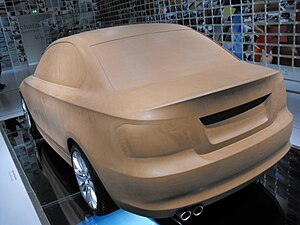| Revision as of 12:14, 16 October 2010 editRubblesby (talk | contribs)210 edits de:wiki← Previous edit | Revision as of 02:03, 25 October 2010 edit undo99.190.46.201 (talk) as opposed to real clayNext edit → | ||
| Line 4: | Line 4: | ||
| '''Clay''' or '''industrial plasticine''' is a modeling material which is mainly used by ] studios. It was developed as an industrial version of ] or hobby clay. | '''Clay''' or '''industrial plasticine''' is a modeling material which is mainly used by ] studios. It was developed as an industrial version of ] or hobby clay. | ||
| Industrial plasticine is based on ] and typically contains ], which gives a characteristic smell to most clays. Often, the styled object will be used to create ]s from. However, largely because sulfur can interfere with some mold-making processes, especially if clay surfaces are unsealed surfaces and platinum-cure ] (room temperature vulcanizing) ] is used, sulfur-free variants are now available; these are usually much lighter than sulfur-containing clays. | Industrial plasticine is based on ] and typically contains ], which gives a characteristic smell to most artificial clays. Often, the styled object will be used to create ]s from. However, largely because sulfur can interfere with some mold-making processes, especially if clay surfaces are unsealed surfaces and platinum-cure ] (room temperature vulcanizing) ] is used, sulfur-free variants are now available; these are usually much lighter than sulfur-containing clays. | ||
| ==Design studios== | ==Design studios== | ||
Revision as of 02:03, 25 October 2010
| This article does not cite any sources. Please help improve this article by adding citations to reliable sources. Unsourced material may be challenged and removed. Find sources: "Industrial plasticine" – news · newspapers · books · scholar · JSTOR (December 2009) (Learn how and when to remove this message) |


Clay or industrial plasticine is a modeling material which is mainly used by automotive design studios. It was developed as an industrial version of plasticine or hobby clay.
Industrial plasticine is based on wax and typically contains sulfur, which gives a characteristic smell to most artificial clays. Often, the styled object will be used to create molds from. However, largely because sulfur can interfere with some mold-making processes, especially if clay surfaces are unsealed surfaces and platinum-cure RTV (room temperature vulcanizing) silicone rubber is used, sulfur-free variants are now available; these are usually much lighter than sulfur-containing clays.
Design studios
Before a new car model is launched, a long period of finding the right design takes place. Even today, computer models are not sufficient to evaluate the quality of a design. Therefore 1:4 or even 1:1 models are built to get an impression of the final car. These models are created in clay, and usually consist of a wooden or iron frame which is covered with Styrofoam. Clay is loaded on top of the foam. Modelers then use various tools and slicks to finalise the shape of the car.
Suppliers
There are three main clay producers which are operating worldwide.
- Eberhard Faber from Germany, which is also known for FIMO.
- Kolb (Franz Kolb Nachfolger, Kolb Technology and Kolb America), the company of the plasticine inventor Franz Kolb.
- Chavant, which was founded by the French chemist Claude Chavant and is now located in New Jersey.